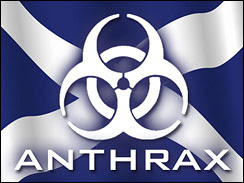 How the Anthrax Spreads.
How the Anthrax Spreads.ANTHRAX: Danger we face

Anthrax is a deadly disease caused by the bacteria Bacillus anthracis. This disease has animal origin and mainly the victims are the grazing animals. However, the disease can spread to humans, who come in contact either with the affected animals or their burial grounds. Anthrax is not a contagious disease and does not spread from person toperson. This disease is known to spread from animals or by bioterrorism
.

Anthrax bacteria have long life and can survive in soil for many years. Wild or domestic animals that graze in or around the soil can get infected while eating rough or irritant vegetation. Such vegetation when eaten causes wound within the gastrointestinal tract and this causes the bacteria to enter into the tissues. The bacteria start multiplying and begin producing toxins which finally leads to death.
Exposure to infected animals or their products such as skin, wool or meat is the route taken by the bacteria to enter the human body. Workers, who work with dead animals or their products, are at a greater risk to this disease. People who are exposed to low levels of these bacteria may not develop the infection as the body’s defense mechanism is strong enough to withstand it. A dangerous form of anthrax through inhalation while sorting wool was prevalent long back and this was known as Wool Sorter’s disease. Now such infections are very rare as the infected animals are not available any more.
Anthrax pores have been used as biological weapons of mass destruction. The last reported use was by the Rhodesian government against cattle and humans during its war with black nationalists in 1978-1979. Anthrax was deliberately spread using the postal system in United States in 2001. This caused 21 cases of Anthrax infection.
Anthrax infection can come through three routes. Through the skin, while handling products of infected animals; through inhalation by inhaling anthrax pores from animal products; or through gastrointestinal path by eating undercooked meat from infected animals.

No comments:
Post a Comment